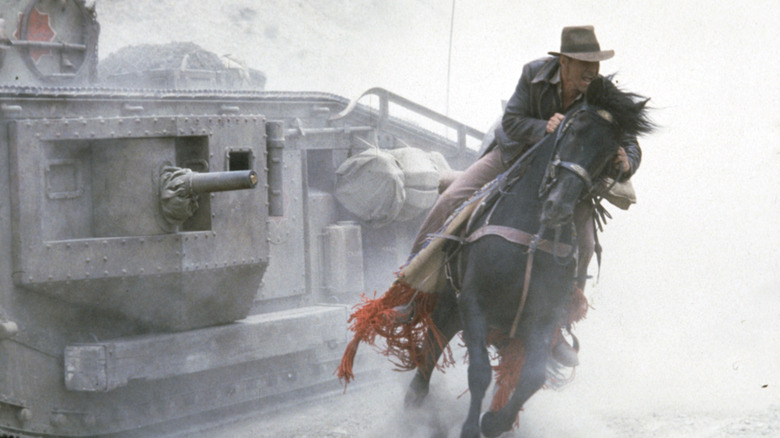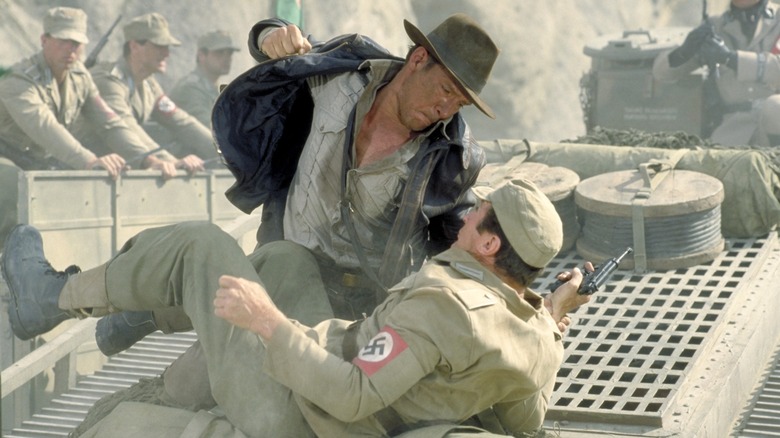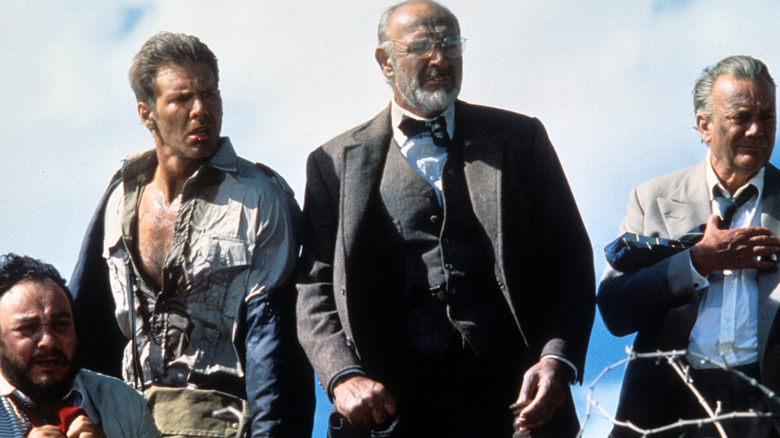The Tank Chase In Indiana Jones And The Last Crusade Is The Best Action Scene Ever
(Welcome to Best Action Scene Ever, a column dedicated to breaking down the best, most effective action sequences throughout the genre. In this edition, we mark the release of "Indiana Jones and the Dial of Destiny" by looking back at arguably the standout action sequence of the entire franchise: the tank chase in "Indiana Jones and the Last Crusade.")
When the average moviegoer thinks of Steven Spielberg, the first thing to come to mind is likely the classic Amblin sense of sentimentality that grounds the vast majority of his movies in a childlike perspective of awe and wonder. Well, that and the pervasive daddy issues present and accounted for in so much of his work. Well, 1989's "Indiana Jones and the Last Crusade" manages to do both at the same time ... but with the added wrinkle of delivering one of the greatest action scenes of all time. Spielberg is rightfully considered one of our greatest living filmmakers, but his intuitive and expert-level grasp of action sometimes manages to go unnoticed. That's the price of making things look too easy, I suppose, but let's just say there's a reason why he's the first director to make a repeat appearance in this column, following our earlier appreciation of "The Adventures of Tintin" at the beginning of the year. This surely won't be the last time, either.
While it basically came down to a coin flip to choose between this and the immaculate truck sequence in "Raiders of the Lost Ark," we decided to go with the slightly better movie (I said what I said!) and dive into exactly what makes this tank chase work as well as it does.
The scene
By this point in "The Last Crusade," Indiana Jones (Harrison Ford) has narrowly survived a rat-infested tomb containing clues to the location of the Holy Grail, a perilous boat chase through the canals of Venice, imprisonment at the hands of Nazis in Austria, and a chase taking both Indy and his father Henry, Sr. (Sean Connery) from a German zeppelin to a biplane to a foot chase as a Luftwaffe fighter plane bears down on them. Oh, and at one point Indy comes face-to-face with the Führer himself and lives to tell the tale. So when the surprisingly lengthy tank sequence begins fairly late in the film, it could've easily felt like overkill to impatient audience members who simply wanted to see our group of heroes make it to their goal.
Instead, Spielberg and co-writers George Lucas, Menno Meyjes, and Jeffrey Boam managed to construct one of the most thrilling story-within-a-story set pieces in blockbuster history. The scene begins with Indy, his father, and dear friend Sallah (John Rhys-Davies) intent on rescuing the bumbling academic Marcus Brody (Denholm Elliott) from the Nazis and beating them to the location of the Grail. The catch: Indy spying on the convoy from afar through shiny, reflective binoculars gives away their position and, one well-placed tank shell later, their only means of transportation is destroyed. ("That car belonged to my brother-in-law," Sallah mournfully states as a fiery wheel rolls on by in one of Spielberg's many visual gags.) With nowhere else to go and Brody moved into the tank for safekeeping, the odds are stacked against Indy before the action even begins.
But in another twist, the arrival of the Order of the Cruciform Sword, the secret society tasked with protecting the Grail against all intruders, throws everything into chaos.
Why it works
One of Spielberg's absolute greatest strengths when putting together an action sequence is his ability to spin multiple plates in the air in such a way that each and every one compounds the other like a Rube Goldberg machine — all without ever losing track of the emotional core and the humanity at the center of the set piece. In this instance, "The Last Crusade" constantly foregrounds Indy's strained relationship with his long-lost father throughout the globetrotting adventure. And staring down his old man's withering disapproval over allowing the Nazis to capture Brody and, by extension, locate Henry's map pointing towards the Grail, Indy spurs into action.
With the distraction provided by unexpected ally Kazim (Kevork Malikyan) and his Order, Indy slips into the midst of the Nazis to steal horses (not camels!) that can get them to the Grail first. But, in another setback, Henry has gone off to rescue Brody himself ... and gotten himself captured for his trouble. And so, with the emotional centerpiece of Indy's arc now trapped by the villainous Nazi officer Ernst Vogel (Michael Byrne) in the very same tank that poses the largest obstacle to our hero, Spielberg kicks off the most visceral sequence in the entire film.
With only a horse, his wits, and a fair amount of luck to contend with the might of a tank and an entire Nazi convoy, Indiana promptly gets to work doing what he does best: improvising. In as well-staged a sequence as you'll ever see, Indy only barely escapes getting squished between the tank and a rock face while frequent cut-ins to Henry and Brody fighting off the Nazis inside juxtaposes Indy fist-fighting henchmen above. All this converges with the biggest obstacle of them all: the out-of-control tank careening towards a cliff.
The key moment
It's one thing to employ a series of incredibly effective vignettes of our heroes in mortal danger and only barely escaping by the skin of their teeth. It's another entirely to ensure that it all hangs together in a way that reveals character and theme through action.
Throughout this entire sequence, viewers might be under the impression that Indy is mainly driven by hatred of the double agent Walter Donovan (Julian Glover) and the Nazis in general, and that's partially correct. But more than anything else, Spielberg emphasizes again and again how much Indy panics over the idea of losing his father. As emphasized by the opening sequence of the movie, the archaeologist will go to extraordinary lengths to gain his distant father's approval. And even as Indy's fighting off an entire contingent of Nazis, it's clear that the tank chase is steadily building to a major turning point between father and son.
So when Indy manages to get both Brody and Henry, Sr. out of harm's way and seemingly tumbles off the cliff with the tank, it's far more than just a cheap fake-out death to wring shock out of the more gullible members of the audience. What matters most is that Henry thinks that Indy has plunged to his death, forcing him out of his insufferably aloof shell and confronting him with his very real feelings for his own son: "Oh God, I've lost him. And I never told him anything ... five minutes would have been enough." And when Indy inexplicably climbs over the edge, that hug the two share sets up the emotional crux of the final act when Henry is put into mortal danger himself and immediately ranks among the best moments in the entire series. That's the magic of Spielberg.


